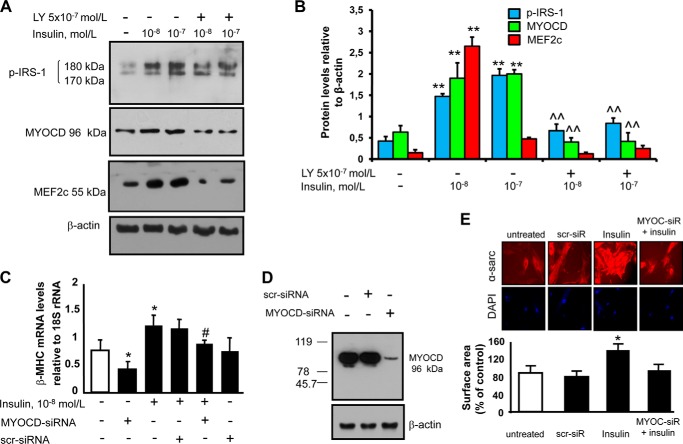FIGURE 1.
Myocardin induction by insulin and myocardin requirement for insulin-mediated induction of myosin heavy chain-β. A and B, myocardin (MYOCD) up-regulation in response to insulin treatment. Canine cardiac myoblasts were starved by growth factor withdrawal and serum reduction (decreased to 2%) for 12 h, followed by stimulation with pathophysiologically relevant concentrations of insulin (10−8-10−7 mol/liter) for 24 h with or without the Akt inhibitor LY294002 (5 × 10−7 mol/liter), which was added to the medium 30 min prior to insulin. Following treatments, the expression of myocardin, MEF2c, and p-IRS-1 were detected by immunoblotting. Blots shown are representative of three independent experiments. The results of scanning densitometry (n = 3 independent experiments) are expressed as arbitrary units in panel B. Columns and bars represent the mean ± S.D. (**, p < 0.01, versus untreated cells; ^^, p < 0.01 versus insulin-treated cells). C, myocardin requirement for insulin-mediated induction of the hypertrophy marker β-MHC. Canine cardiac myoblasts were transfected with a pool of three different siRNAs against myocardin or a scrambled (scr) siRNA (negative control) and treated with insulin (10−7 mol/liter) for 6 h. Total RNA was analyzed by real-time quantitative-PCR with primer sets specific for β-MHC. Data (means ± S.D. of three independent experiments) are presented as relative mRNA expression (normalized to RNA 18 S). *, p < 0.05 versus untreated cells; #, p < 0.05 versus insulin treated cells. D, levels of myocardin in total protein extracts isolated from canine cardiac myoblasts transfected with a pool of three different siRNAs against myocardin or scrambled siRNA (negative control). Blots are representative of three independent experiments. E, insulin treatment (10−8 mol/liter) led to cell size increase, which was blocked by myocardin-siRNA. Representative photos show cell size of canine cardiac myoblasts. Canine cardiac myoblasts were treated as described for A–C. After treatment, cells were permeabilized and fixed for the staining with α-sarcomeric actinin (α-sarc). Nuclei were stained with 4′,6-diamidino-2-phenylindole.

